Just a short while ago, Intel announced that its 22nm process would not use the conventional planar transistors that are featured in most of today's chips, but it will instead go with 3D Tri-Gate transistors. The first high-volume chips to use this evolutionary 3-D transistor design are the upcoming Ivy Bridge CPUs.
Compared to planar transistors, Intel's three-dimensional Tri-Gate technology allows for a series of improvements which should lead to more energy efficient processor designs.
At the same time, it should improve the performance of the chips, as it decreases the transistor switching time, and allow for higher transistor densities to be reached.
In fact, Intel is claiming that the move to 22nm Tri-Gate improves the density twofold, meaning that twice as many transistors can be fitted inside the same amount of die space.
As noted earlier, Ivy Bridge will be the first high-volume chip to use a Tri-Gate design and the increases in switching speed at the same voltage could allow Intel to exceed the 4GHz barrier with its Extreme Edition processors.
Although Ivy Bridge could surely benefit from the energy-efficient design and improved clock speeds brought by Tri-Gate transistors, the new manufacturing technology could bring even bigger news for Atom.
These chips have had a rough time getting into low power consumption devices such as smartphones and tablets and Tri-Gate could allow Intel to effectively compete with ARM, provided that it moves fast enough.
“The performance gains and power savings of Intel's unique 3-D Tri-Gate transistors are like nothing we've seen before,” said Mark Bohr, Intel senior fellow.
“This milestone is going further than simply keeping up with Moore's Law. The low-voltage and low-power benefits far exceed what we typically see from one process generation to the next.
“It will give product designers the flexibility to make current devices smarter and wholly new ones possible.”

 14 DAY TRIAL //
14 DAY TRIAL //